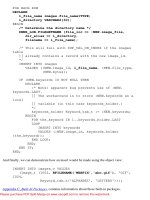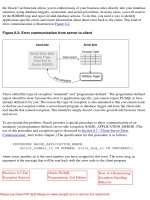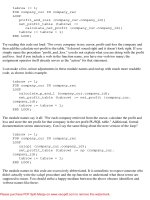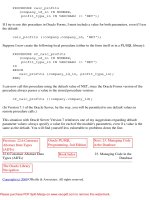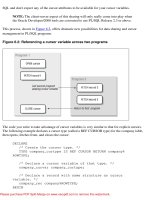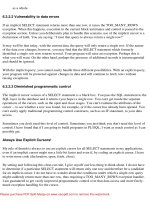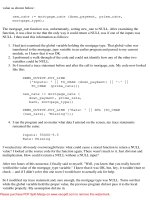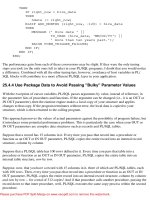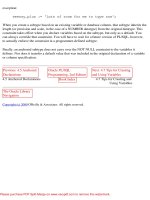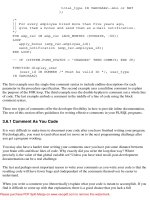Oracle® Database PL/SQL Language Reference ppt
Bạn đang xem bản rút gọn của tài liệu. Xem và tải ngay bản đầy đủ của tài liệu tại đây (11.91 MB, 712 trang )
Oracle® Database
PL/SQL Language Reference
11g Release 1 (11.1)
B28370-05
August 2009
Oracle Database PL/SQL Language Reference, 11g Release 1 (11.1)
B28370-05
Copyright © 1996, 2009, Oracle and/or its affiliates. All rights reserved.
Primary Author: Sheila Moore
Contributing Author: E. Belden
Contributors: S. Agrawal, C. Barclay, D. Bronnikov, S. Castledine, T. Chang, B. Cheng, R. Dani, R. Decker,
C. Iyer, S. Kotsovolos, N. Le, W. Li, S. Lin, B. Llewellyn, D. Lorentz, V. Moore, K. Muthukkaruppan, C.
Racicot, J. Russell, C. Wetherell, M. Vemulapati, G. Viswanathan, M. Yang
This software and related documentation are provided under a license agreement containing restrictions on
use and disclosure and are protected by intellectual property laws. Except as expressly permitted in your
license agreement or allowed by law, you may not use, copy, reproduce, translate, broadcast, modify, license,
transmit, distribute, exhibit, perform, publish, or display any part, in any form, or by any means. Reverse
engineering, disassembly, or decompilation of this software, unless required by law for interoperability, is
prohibited.
The information contained herein is subject to change without notice and is not warranted to be error-free. If
you find any errors, please report them to us in writing.
If this software or related documentation is delivered to the U.S. Government or anyone licensing it on
behalf of the U.S. Government, the following notice is applicable:
U.S. GOVERNMENT RIGHTS Programs, software, databases, and related documentation and technical data
delivered to U.S. Government customers are "commercial computer software" or "commercial technical data"
pursuant to the applicable Federal Acquisition Regulation and agency-specific supplemental regulations. As
such, the use, duplication, disclosure, modification, and adaptation shall be subject to the restrictions and
license terms set forth in the applicable Government contract, and, to the extent applicable by the terms of
the Government contract, the additional rights set forth in FAR 52.227-19, Commercial Computer Software
License (December 2007). Oracle USA, Inc., 500 Oracle Parkway, Redwood City, CA 94065.
This software is developed for general use in a variety of information management applications. It is not
developed or intended for use in any inherently dangerous applications, including applications which may
create a risk of personal injury. If you use this software in dangerous applications, then you shall be
responsible to take all appropriate fail-safe, backup, redundancy, and other measures to ensure the safe use
of this software. Oracle Corporation and its affiliates disclaim any liability for any damages caused by use of
this software in dangerous applications.
Oracle is a registered trademark of Oracle Corporation and/or its affiliates. Other names may be trademarks
of their respective owners.
This software and documentation may provide access to or information on content, products, and services
from third parties. Oracle Corporation and its affiliates are not responsible for and expressly disclaim all
warranties of any kind with respect to third-party content, products, and services. Oracle Corporation and
its affiliates will not be responsible for any loss, costs, or damages incurred due to your access to or use of
third-party content, products, or services.
v
Contents
Preface xxxi
Audience xxxi
Documentation Accessibility xxxi
Related Documents xxxii
Conventions xxxii
Syntax Descriptions xxxiii
What's New in PL/SQL? xxxv
New PL/SQL Features for 11g Release 1 (11.1) xxxv
1 Overview of PL/SQL
Advantages of PL/SQL 1-1
Tight Integration with SQL 1-1
High Performance 1-2
High Productivity 1-2
Full Portability 1-3
Tight Security 1-3
Access to Predefined Packages 1-3
Support for Object-Oriented Programming 1-3
Support for Developing Web Applications and Server Pages 1-4
Main Features of PL/SQL 1-4
PL/SQL Blocks 1-4
PL/SQL Error Handling 1-5
PL/SQL Input and Output 1-6
PL/SQL Variables and Constants 1-6
Declaring PL/SQL Variables 1-6
Assigning Values to Variables 1-7
Declaring PL/SQL Constants 1-9
Bind Variables 1-9
PL/SQL Data Abstraction 1-9
Cursors 1-10
%TYPE Attribute 1-10
%ROWTYPE Attribute 1-10
Collections 1-11
Records 1-12
vi
Object Types 1-12
PL/SQL Control Structures 1-13
Conditional Control 1-13
Iterative Control 1-15
Sequential Control 1-17
PL/SQL Subprograms 1-17
Standalone PL/SQL Subprograms 1-18
Triggers 1-19
PL/SQL Packages (APIs Written in PL/SQL) 1-20
Conditional Compilation 1-23
Embedded SQL Statements 1-23
Architecture of PL/SQL 1-24
PL/SQL Engine 1-24
PL/SQL Units and Compilation Parameters 1-25
2 PL/SQL Language Fundamentals
Character Sets and Lexical Units 2-1
Delimiters 2-3
Identifiers 2-4
Reserved Words and Keywords 2-5
Predefined Identifiers 2-5
Quoted Identifiers 2-5
Literals 2-6
Numeric Literals 2-6
Character Literals 2-7
String Literals 2-7
BOOLEAN Literals 2-8
Date and Time Literals 2-8
Comments 2-9
Single-Line Comments 2-9
Multiline Comments 2-10
Declarations 2-10
Variables 2-11
Constants 2-11
Using DEFAULT 2-11
Using NOT NULL 2-12
Using the %TYPE Attribute 2-12
Using the %ROWTYPE Attribute 2-15
Aggregate Assignment 2-16
Using Aliases 2-17
Restrictions on Declarations 2-18
Naming Conventions 2-19
Scope 2-19
Case Sensitivity 2-20
Name Resolution 2-20
Synonyms 2-22
Scope and Visibility of PL/SQL Identifiers 2-22
vii
Assigning Values to Variables 2-26
Assigning BOOLEAN Values 2-27
Assigning SQL Query Results to PL/SQL Variables 2-27
PL/SQL Expressions and Comparisons 2-28
Concatenation Operator 2-28
Operator Precedence 2-28
Logical Operators 2-30
Order of Evaluation 2-33
Short-Circuit Evaluation 2-34
Comparison Operators 2-34
IS NULL Operator 2-35
LIKE Operator 2-35
BETWEEN Operator 2-37
IN Operator 2-37
BOOLEAN Expressions 2-38
BOOLEAN Arithmetic Expressions 2-38
BOOLEAN Character Expressions 2-39
BOOLEAN Date Expressions 2-39
Guidelines for BOOLEAN Expressions 2-40
CASE Expressions 2-40
Simple CASE Expression 2-41
Searched CASE Expression 2-41
Handling NULL Values in Comparisons and Conditional Statements 2-42
NULL Values and the NOT Operator 2-43
NULL Values and Zero-Length Strings 2-44
NULL Values and the Concatenation Operator 2-44
NULL Values as Arguments to Built-In Functions 2-45
PL/SQL Error-Reporting Functions 2-47
Using SQL Functions in PL/SQL 2-47
Conditional Compilation 2-48
How Does Conditional Compilation Work? 2-48
Conditional Compilation Control Tokens 2-48
Using Conditional Compilation Selection Directives 2-49
Using Conditional Compilation Error Directives 2-49
Using Conditional Compilation Inquiry Directives 2-49
Using Predefined Inquiry Directives with Conditional Compilation 2-50
Using Static Expressions with Conditional Compilation 2-50
Boolean Static Expressions 2-51
PLS_INTEGER Static Expressions 2-51
VARCHAR2 Static Expressions 2-51
Static Constants 2-52
Using DBMS_DB_VERSION Package Constants 2-53
Conditional Compilation Examples 2-54
Using Conditional Compilation to Specify Code for Database Versions 2-54
Using DBMS_PREPROCESSOR Procedures to Print or Retrieve Source Text 2-55
Conditional Compilation Restrictions 2-55
Using PL/SQL to Create Web Applications 2-56
viii
Using PL/SQL to Create Server Pages 2-57
3 PL/SQL Data Types
Predefined PL/SQL Scalar Data Types and Subtypes 3-1
Predefined PL/SQL Numeric Data Types and Subtypes 3-2
PLS_INTEGER and BINARY_INTEGER Data Types 3-2
SIMPLE_INTEGER Subtype of PLS_INTEGER 3-3
Overflow Semantics 3-3
Overloading Rules 3-4
Integer Literals 3-4
Cast Operations 3-5
Compiler Warnings 3-5
BINARY_FLOAT and BINARY_DOUBLE Data Types 3-5
NUMBER Data Type 3-6
Predefined PL/SQL Character Data Types and Subtypes 3-7
CHAR and VARCHAR2 Data Types 3-8
Predefined Subtypes of Character Data Types 3-9
Memory Allocation for Character Variables 3-9
Blank-Padding Shorter Character Values 3-10
Comparing Character Values 3-10
Maximum Sizes of Values Inserted into Character Database Columns 3-11
RAW Data Type 3-12
NCHAR and NVARCHAR2 Data Types 3-12
AL16UTF16 and UTF8 Encodings 3-12
NCHAR Data Type 3-13
NVARCHAR2 Data Type 3-14
LONG and LONG RAW Data Types 3-14
ROWID and UROWID Data Types 3-14
Predefined PL/SQL BOOLEAN Data Type 3-15
Predefined PL/SQL Datetime and Interval Data Types 3-15
DATE Data Type 3-16
TIMESTAMP Data Type 3-17
TIMESTAMP WITH TIME ZONE Data Type 3-18
TIMESTAMP WITH LOCAL TIME ZONE Data Type 3-19
INTERVAL YEAR TO MONTH Data Type 3-20
INTERVAL DAY TO SECOND Data Type 3-20
Datetime and Interval Arithmetic 3-21
Avoiding Truncation Problems Using Date and Time Subtypes 3-21
Predefined PL/SQL Large Object (LOB) Data Types 3-22
BFILE Data Type 3-23
BLOB Data Type 3-23
CLOB Data Type 3-23
NCLOB Data Type 3-23
User-Defined PL/SQL Subtypes 3-23
Defining Subtypes 3-24
Using Subtypes 3-24
Type Compatibility with Subtypes 3-25
ix
Constraints and Default Values with Subtypes 3-26
PL/SQL Data Type Conversion 3-28
Explicit Conversion 3-28
Implicit Conversion 3-29
4 Using PL/SQL Control Structures
Overview of PL/SQL Control Structures 4-1
Testing Conditions (IF and CASE Statements) 4-2
Using the IF-THEN Statement 4-2
Using the IF-THEN-ELSE Statement 4-2
Using the IF-THEN-ELSIF Statement 4-4
Using the Simple CASE Statement 4-5
Using the Searched CASE Statement 4-6
Guidelines for IF and CASE Statements 4-7
Controlling Loop Iterations (LOOP, EXIT, and CONTINUE Statements) 4-8
Using the Basic LOOP Statement 4-9
Using the EXIT Statement 4-9
Using the EXIT-WHEN Statement 4-10
Using the CONTINUE Statement 4-10
Using the CONTINUE-WHEN Statement 4-11
Labeling a PL/SQL Loop 4-12
Using the WHILE-LOOP Statement 4-13
Using the FOR-LOOP Statement 4-13
How PL/SQL Loops Repeat 4-15
Dynamic Ranges for Loop Bounds 4-16
Scope of the Loop Counter Variable 4-17
Using the EXIT Statement in a FOR Loop 4-19
Sequential Control (GOTO and NULL Statements) 4-20
Using the GOTO Statement 4-20
GOTO Statement Restrictions 4-22
Using the NULL Statement 4-23
5 Using PL/SQL Collections and Records
Understanding PL/SQL Collection Types 5-1
Understanding Associative Arrays (Index-By Tables) 5-2
Understanding Nested Tables 5-4
Understanding Variable-Size Arrays (Varrays) 5-5
Choosing PL/SQL Collection Types 5-5
Choosing Between Nested Tables and Associative Arrays 5-5
Choosing Between Nested Tables and Varrays 5-6
Defining Collection Types 5-6
Declaring Collection Variables 5-8
Initializing and Referencing Collections 5-10
Referencing Collection Elements 5-12
Assigning Values to Collections 5-13
Comparing Collections 5-17
x
Using Multidimensional Collections 5-19
Using Collection Methods 5-20
Checking If a Collection Element Exists (EXISTS Method) 5-21
Counting the Elements in a Collection (COUNT Method) 5-21
Checking the Maximum Size of a Collection (LIMIT Method) 5-22
Finding the First or Last Collection Element (FIRST and LAST Methods) 5-22
Looping Through Collection Elements (PRIOR and NEXT Methods) 5-23
Increasing the Size of a Collection (EXTEND Method) 5-24
Decreasing the Size of a Collection (TRIM Method) 5-26
Deleting Collection Elements (DELETE Method) 5-27
Applying Methods to Collection Parameters 5-28
Avoiding Collection Exceptions 5-28
Defining and Declaring Records 5-31
Using Records as Subprogram Parameters and Function Return Values 5-33
Assigning Values to Records 5-34
Comparing Records 5-36
Inserting Records Into the Database 5-36
Updating the Database with Record Values 5-36
Restrictions on Record Inserts and Updates 5-38
Querying Data Into Collections of Records 5-38
6 Using Static SQL
Description of Static SQL 6-1
Data Manipulation Language (DML) Statements 6-1
Transaction Control Language (TCL) Statements 6-3
SQL Functions 6-3
SQL Pseudocolumns 6-4
CURRVAL and NEXTVAL 6-4
LEVEL 6-5
ROWID 6-5
ROWNUM 6-6
SQL Operators 6-6
Comparison Operators 6-6
Set Operators 6-7
Row Operators 6-7
Managing Cursors in PL/SQL 6-7
SQL Cursors (Implicit) 6-7
Attributes of SQL Cursors 6-8
%FOUND Attribute: Has a DML Statement Changed Rows? 6-8
%ISOPEN Attribute: Always FALSE for SQL Cursors 6-8
%NOTFOUND Attribute: Has a DML Statement Failed to Change Rows? 6-8
%ROWCOUNT Attribute: How Many Rows Affected So Far? 6-8
Guidelines for Using Attributes of SQL Cursors 6-9
Explicit Cursors 6-9
Declaring a Cursor 6-10
Opening a Cursor 6-11
Fetching with a Cursor 6-11
xi
Fetching Bulk Data with a Cursor 6-12
Closing a Cursor 6-13
Attributes of Explicit Cursors 6-13
%FOUND Attribute: Has a Row Been Fetched? 6-13
%ISOPEN Attribute: Is the Cursor Open? 6-14
%NOTFOUND Attribute: Has a Fetch Failed? 6-14
%ROWCOUNT Attribute: How Many Rows Fetched So Far? 6-15
Querying Data with PL/SQL 6-16
Selecting At Most One Row (SELECT INTO Statement) 6-16
Selecting Multiple Rows (BULK COLLECT Clause) 6-17
Looping Through Multiple Rows (Cursor FOR Loop) 6-17
Performing Complicated Query Processing (Explicit Cursors) 6-17
Cursor FOR LOOP 6-18
SQL Cursor FOR LOOP 6-18
Explicit Cursor FOR LOOP 6-18
Defining Aliases for Expression Values in a Cursor FOR Loop 6-19
Using Subqueries 6-19
Using Correlated Subqueries 6-20
Writing Maintainable PL/SQL Subqueries 6-21
Using Cursor Variables (REF CURSORs) 6-22
What Are Cursor Variables (REF CURSORs)? 6-23
Why Use Cursor Variables? 6-23
Declaring REF CURSOR Types and Cursor Variables 6-23
Passing Cursor Variables As Parameters 6-24
Controlling Cursor Variables (OPEN-FOR, FETCH, and CLOSE Statements) 6-25
Opening a Cursor Variable 6-25
Using a Cursor Variable as a Host Variable 6-27
Fetching from a Cursor Variable 6-28
Closing a Cursor Variable 6-29
Reducing Network Traffic When Passing Host Cursor Variables to PL/SQL 6-29
Avoiding Errors with Cursor Variables 6-30
Restrictions on Cursor Variables 6-30
Using Cursor Expressions 6-31
Overview of Transaction Processing in PL/SQL 6-32
Using COMMIT in PL/SQL 6-33
Using ROLLBACK in PL/SQL 6-34
Using SAVEPOINT in PL/SQL 6-35
How the Database Does Implicit Rollbacks 6-36
Ending Transactions 6-36
Setting Transaction Properties (SET TRANSACTION Statement) 6-37
Overriding Default Locking 6-37
Using FOR UPDATE 6-38
Using LOCK TABLE 6-39
Fetching Across Commits 6-39
Doing Independent Units of Work with Autonomous Transactions 6-40
Advantages of Autonomous Transactions 6-41
Defining Autonomous Transactions 6-41
xii
Comparison of Autonomous Transactions and Nested Transactions 6-43
Transaction Context 6-43
Transaction Visibility 6-43
Controlling Autonomous Transactions 6-44
Entering and Exiting 6-44
Committing and Rolling Back 6-44
Using Savepoints 6-44
Avoiding Errors with Autonomous Transactions 6-45
Using Autonomous Triggers 6-45
Invoking Autonomous Functions from SQL 6-46
7 Using Dynamic SQL
When You Need Dynamic SQL 7-1
Using Native Dynamic SQL 7-2
Using the EXECUTE IMMEDIATE Statement 7-2
Using the OPEN-FOR, FETCH, and CLOSE Statements 7-4
Repeating Placeholder Names in Dynamic SQL Statements 7-5
Dynamic SQL Statement is Not Anonymous Block or CALL Statement 7-5
Dynamic SQL Statement is Anonymous Block or CALL Statement 7-5
Using DBMS_SQL Package 7-6
DBMS_SQL.TO_REFCURSOR Function 7-7
DBMS_SQL.TO_CURSOR_NUMBER Function 7-8
Avoiding SQL Injection in PL/SQL 7-9
Overview of SQL Injection Techniques 7-9
Statement Modification 7-9
Statement Injection 7-11
Data Type Conversion 7-12
Guarding Against SQL Injection 7-14
Using Bind Arguments to Guard Against SQL Injection 7-14
Using Validation Checks to Guard Against SQL Injection 7-15
Using Explicit Format Models to Guard Against SQL Injection 7-17
8 Using PL/SQL Subprograms
Overview of PL/SQL Subprograms 8-1
Subprogram Parts 8-3
Creating Nested Subprograms that Invoke Each Other 8-5
Declaring and Passing Subprogram Parameters 8-6
Formal and Actual Subprogram Parameters 8-6
Specifying Subprogram Parameter Modes 8-7
Using IN Mode 8-8
Using OUT Mode 8-8
Using IN OUT Mode 8-9
Summary of Subprogram Parameter Modes 8-9
Specifying Default Values for Subprogram Parameters 8-9
Passing Actual Subprogram Parameters with Positional, Named, or Mixed Notation 8-11
Overloading PL/SQL Subprogram Names 8-12
Guidelines for Overloading with Numeric Types 8-13
xiii
Restrictions on Overloading 8-14
When Compiler Catches Overloading Errors 8-14
How PL/SQL Subprogram Calls Are Resolved 8-16
Using Invoker's Rights or Definer's Rights (AUTHID Clause) 8-18
Choosing Between AUTHID CURRENT_USER and AUTHID DEFINER 8-19
AUTHID and the SQL Command SET ROLE 8-20
Need for Template Objects in IR Subprograms 8-20
Overriding Default Name Resolution in IR Subprograms 8-20
Using Views and Database Triggers with IR Subprograms 8-20
Using Database Links with IR Subprograms 8-20
Using Object Types with IR Subprograms 8-21
Invoking IR Instance Methods 8-22
Using Recursive PL/SQL Subprograms 8-23
Invoking External Subprograms 8-23
Controlling Side Effects of PL/SQL Subprograms 8-24
Understanding PL/SQL Subprogram Parameter Aliasing 8-25
Using the PL/SQL Function Result Cache 8-27
Enabling Result-Caching for a Function 8-28
Developing Applications with Result-Cached Functions 8-29
Restrictions on Result-Cached Functions 8-29
Examples of Result-Cached Functions 8-30
Result-Cached Application Configuration Parameters 8-30
Result-Cached Recursive Function 8-32
Advanced Result-Cached Function Topics 8-32
Rules for a Cache Hit 8-32
Bypassing the Result Cache 8-33
Making Result-Cached Functions Handle Session-Specific Settings 8-33
Making Result-Cached Functions Handle Session-Specific Application Contexts 8-34
Choosing Result-Caching Granularity 8-35
Result Caches in Oracle RAC Environment 8-36
Managing the Result Cache 8-37
Hot-Patching PL/SQL Units on Which Result-Cached Functions Depend 8-37
9 Using Triggers
Overview of Triggers 9-1
Trigger Types 9-2
Trigger States 9-2
Data Access for Triggers 9-2
Uses of Triggers 9-3
Guidelines for Designing Triggers 9-3
Privileges Required to Use Triggers 9-4
Creating Triggers 9-5
Naming Triggers 9-6
When Does the Trigger Fire? 9-6
Do Import and SQL*Loader Fire Triggers? 9-6
How Column Lists Affect UPDATE Triggers 9-7
Controlling When a Trigger Fires (BEFORE and AFTER Options) 9-7
xiv
Ordering of Triggers 9-8
Modifying Complex Views (INSTEAD OF Triggers) 9-8
Views that Require INSTEAD OF Triggers 9-9
Triggers on Nested Table View Columns 9-9
Example: INSTEAD OF Trigger 9-11
Firing Triggers One or Many Times (FOR EACH ROW Option) 9-12
Firing Triggers Based on Conditions (WHEN Clause) 9-13
Compound Triggers 9-13
Why Use Compound Triggers? 9-13
Compound Trigger Sections 9-14
Triggering Statements of Compound Triggers 9-15
Compound Trigger Restrictions 9-15
Compound Trigger Example 9-16
Using Compound Triggers to Avoid Mutating-Table Error 9-18
Coding the Trigger Body 9-18
Accessing Column Values in Row Triggers 9-20
Example: Modifying LOB Columns with a Trigger 9-20
INSTEAD OF Triggers on Nested Table View Columns 9-21
Avoiding Trigger Name Conflicts (REFERENCING Option) 9-21
Detecting the DML Operation that Fired a Trigger 9-22
Error Conditions and Exceptions in the Trigger Body 9-22
Triggers on Object Tables 9-22
Triggers and Handling Remote Exceptions 9-23
Restrictions on Creating Triggers 9-24
Maximum Trigger Size 9-24
SQL Statements Allowed in Trigger Bodies 9-25
Trigger Restrictions on LONG and LONG RAW Data Types 9-25
Trigger Restrictions on Mutating Tables 9-25
Restrictions on Mutating Tables Relaxed 9-26
System Trigger Restrictions 9-27
Foreign Function Callouts 9-27
Who Uses the Trigger? 9-27
Compiling Triggers 9-27
Dependencies for Triggers 9-28
Recompiling Triggers 9-28
Modifying Triggers 9-29
Debugging Triggers 9-29
Enabling Triggers 9-29
Disabling Triggers 9-29
Viewing Information About Triggers 9-30
Examples of Trigger Applications 9-31
Auditing with Triggers 9-31
Contraints and Triggers 9-35
Referential Integrity Using Triggers 9-36
Foreign Key Trigger for Child Table 9-37
UPDATE and DELETE RESTRICT Trigger for Parent Table 9-37
UPDATE and DELETE SET NULL Triggers for Parent Table 9-38
xv
DELETE Cascade Trigger for Parent Table 9-39
UPDATE Cascade Trigger for Parent Table 9-39
Trigger for Complex Check Constraints 9-40
Complex Security Authorizations and Triggers 9-41
Transparent Event Logging and Triggers 9-42
Derived Column Values and Triggers 9-42
Building Complex Updatable Views Using Triggers 9-43
Fine-Grained Access Control Using Triggers 9-44
Responding to Database Events Through Triggers 9-45
How Events Are Published Through Triggers 9-45
Publication Context 9-46
Error Handling 9-46
Execution Model 9-46
Event Attribute Functions 9-46
Database Events 9-50
Client Events 9-51
10 Using PL/SQL Packages
What is a PL/SQL Package? 10-1
What Goes in a PL/SQL Package? 10-2
Advantages of PL/SQL Packages 10-3
Understanding the PL/SQL Package Specification 10-3
Referencing PL/SQL Package Contents 10-4
Understanding the PL/SQL Package Body 10-5
Examples of PL/SQL Package Features 10-6
Private and Public Items in PL/SQL Packages 10-9
How STANDARD Package Defines the PL/SQL Environment 10-9
Overview of Product-Specific PL/SQL Packages 10-10
DBMS_ALERT Package 10-10
DBMS_OUTPUT Package 10-10
DBMS_PIPE Package 10-11
DBMS_CONNECTION_POOL Package 10-11
HTF and HTP Packages 10-11
UTL_FILE Package 10-11
UTL_HTTP Package 10-11
UTL_SMTP Package 10-11
Guidelines for Writing PL/SQL Packages 10-12
Separating Cursor Specifications and Bodies with PL/SQL Packages 10-12
11 Handling PL/SQL Errors
Overview of PL/SQL Run-Time Error Handling 11-1
Guidelines for Avoiding and Handling PL/SQL Errors and Exceptions 11-2
Advantages of PL/SQL Exceptions 11-3
Predefined PL/SQL Exceptions 11-4
Defining Your Own PL/SQL Exceptions 11-6
Declaring PL/SQL Exceptions 11-6
xvi
Scope Rules for PL/SQL Exceptions 11-6
Associating a PL/SQL Exception with a Number (EXCEPTION_INIT Pragma) 11-7
Defining Your Own Error Messages (RAISE_APPLICATION_ERROR Procedure) 11-8
Redeclaring Predefined Exceptions 11-9
How PL/SQL Exceptions Are Raised 11-9
How PL/SQL Exceptions Propagate 11-10
Reraising a PL/SQL Exception 11-12
Handling Raised PL/SQL Exceptions 11-13
Exceptions Raised in Declarations 11-14
Handling Exceptions Raised in Exception Handlers 11-14
Branching To or from an Exception Handler 11-15
Retrieving the Error Code and Error Message 11-15
Catching Unhandled Exceptions 11-16
Guidelines for Handling PL/SQL Errors 11-16
Continuing Execution After an Exception Is Raised 11-16
Retrying a Transaction 11-17
Using Locator Variables to Identify Exception Locations 11-18
Overview of PL/SQL Compile-Time Warnings 11-19
PL/SQL Warning Categories 11-19
Controlling PL/SQL Warning Messages 11-20
Using DBMS_WARNING Package 11-20
12 Tuning PL/SQL Applications for Performance
How PL/SQL Optimizes Your Programs 12-1
When to Tune PL/SQL Code 12-2
Guidelines for Avoiding PL/SQL Performance Problems 12-3
Avoiding CPU Overhead in PL/SQL Code 12-3
Make SQL Statements as Efficient as Possible 12-3
Make Function Calls as Efficient as Possible 12-4
Make Loops as Efficient as Possible 12-5
Use Built-In String Functions 12-5
Put Least Expensive Conditional Tests First 12-5
Minimize Data Type Conversions 12-5
Use PLS_INTEGER or SIMPLE_INTEGER for Integer Arithmetic 12-6
Use BINARY_FLOAT, BINARY_DOUBLE, SIMPLE_FLOAT, and SIMPLE_DOUBLE for
Floating-Point Arithmetic 12-6
Avoiding Memory Overhead in PL/SQL Code 12-7
Declare VARCHAR2 Variables of 4000 or More Characters 12-7
Group Related Subprograms into Packages 12-7
Pin Packages in the Shared Memory Pool 12-7
Apply Advice of Compiler Warnings 12-7
Collecting Data About User-Defined Identifiers 12-7
Profiling and Tracing PL/SQL Programs 12-8
Using the Profiler API: Package DBMS_PROFILER 12-8
Using the Trace API: Package DBMS_TRACE 12-9
Reducing Loop Overhead for DML Statements and Queries with Bulk SQL 12-9
Running One DML Statement Multiple Times (FORALL Statement) 12-10
xvii
How FORALL Affects Rollbacks 12-14
Counting Rows Affected by FORALL (%BULK_ROWCOUNT Attribute) 12-14
Handling FORALL Exceptions (%BULK_EXCEPTIONS Attribute) 12-16
Retrieving Query Results into Collections (BULK COLLECT Clause) 12-17
Examples of Bulk Fetching from a Cursor 12-19
Limiting Rows for a Bulk FETCH Operation (LIMIT Clause) 12-20
Retrieving DML Results Into a Collection (RETURNING INTO Clause) 12-21
Using FORALL and BULK COLLECT Together 12-21
Using Host Arrays with Bulk Binds 12-22
SELECT BULK COLLECT INTO Statements and Aliasing 12-22
Writing Computation-Intensive PL/SQL Programs 12-27
Tuning Dynamic SQL with EXECUTE IMMEDIATE Statement and Cursor Variables 12-27
Tuning PL/SQL Subprogram Calls with NOCOPY Hint 12-28
Compiling PL/SQL Units for Native Execution 12-30
Determining Whether to Use PL/SQL Native Compilation 12-30
How PL/SQL Native Compilation Works 12-31
Dependencies, Invalidation, and Revalidation 12-31
Setting Up a New Database for PL/SQL Native Compilation 12-31
Compiling the Entire Database for PL/SQL Native or Interpreted Compilation 12-32
Performing Multiple Transformations with Pipelined Table Functions 12-34
Overview of Pipelined Table Functions 12-34
Writing a Pipelined Table Function 12-35
Using Pipelined Table Functions for Transformations 12-36
Returning Results from Pipelined Table Functions 12-37
Pipelining Data Between PL/SQL Table Functions 12-37
Optimizing Multiple Calls to Pipelined Table Functions 12-38
Fetching from Results of Pipelined Table Functions 12-38
Passing Data with Cursor Variables 12-38
Performing DML Operations Inside Pipelined Table Functions 12-41
Performing DML Operations on Pipelined Table Functions 12-41
Handling Exceptions in Pipelined Table Functions 12-42
13 PL/SQL Language Elements
Assignment Statement 13-3
AUTONOMOUS_TRANSACTION Pragma 13-6
Block 13-8
CASE Statement 13-15
CLOSE Statement 13-18
Collection 13-19
Collection Method Call 13-23
Comment 13-27
Constant 13-28
CONTINUE Statement 13-31
Cursor Attribute 13-32
Cursor Variable Declaration 13-34
EXCEPTION_INIT Pragma 13-38
Exception Declaration 13-39
xviii
Exception Handler 13-40
EXECUTE IMMEDIATE Statement 13-42
EXIT Statement 13-45
Explicit Cursor 13-47
Expression 13-51
FETCH Statement 13-60
FORALL Statement 13-63
Function Declaration and Definition 13-66
GOTO Statement 13-70
IF Statement 13-71
INLINE Pragma 13-73
Literal 13-76
LOOP Statements 13-79
NULL Statement 13-84
OPEN Statement 13-85
OPEN-FOR Statement 13-87
Parameter Declaration 13-90
Procedure Declaration and Definition 13-92
RAISE Statement 13-94
Record Definition 13-95
RESTRICT_REFERENCES Pragma 13-98
RETURN Statement 13-100
RETURNING INTO Clause 13-102
%ROWTYPE Attribute 13-105
SELECT INTO Statement 13-107
SERIALLY_REUSABLE Pragma 13-111
SQL (Implicit) Cursor Attribute 13-113
SQLCODE Function 13-116
SQLERRM Function 13-117
%TYPE Attribute 13-119
Variable 13-121
14 SQL Statements for Stored PL/SQL Units
ALTER FUNCTION Statement 14-3
ALTER PACKAGE Statement 14-6
ALTER PROCEDURE Statement 14-9
ALTER TRIGGER Statement 14-11
ALTER TYPE Statement 14-14
CREATE FUNCTION Statement 14-27
CREATE PACKAGE Statement 14-36
CREATE PACKAGE BODY Statement 14-39
CREATE PROCEDURE Statement 14-42
CREATE TRIGGER Statement 14-47
CREATE TYPE Statement 14-60
CREATE TYPE BODY Statement 14-77
DROP FUNCTION Statement 14-82
DROP PACKAGE Statement 14-84
xix
DROP PROCEDURE Statement 14-86
DROP TRIGGER Statement 14-87
DROP TYPE Statement 14-88
DROP TYPE BODY Statement 14-90
A Wrapping PL/SQL Source Code
Overview of Wrapping A-1
Guidelines for Wrapping A-1
Limitations of Wrapping A-2
Wrapping PL/SQL Code with wrap Utility A-2
Input and Output Files for the PL/SQL wrap Utility A-3
Running the wrap Utility A-3
Limitations of the wrap Utility A-4
Wrapping PL/QL Code with DBMS_DDL Subprograms A-4
Using DBMS_DDL.CREATE_WRAPPED Procedure A-5
Limitation of the DBMS_DDL.WRAP Function A-6
B How PL/SQL Resolves Identifier Names
What is Name Resolution? B-1
Examples of Qualified Names and Dot Notation B-2
How Name Resolution Differs in PL/SQL and SQL B-4
What is Capture? B-4
Inner Capture B-4
Same-Scope Capture B-5
Outer Capture B-5
Avoiding Inner Capture in DML Statements B-5
Qualifying References to Attributes and Methods B-6
Qualifying References to Row Expressions B-7
C PL/SQL Program Limits
D PL/SQL Reserved Words and Keywords
Index
xx
xxi
List of Examples
1–1 PL/SQL Block Structure 1-4
1–2 PL/SQL Variable Declarations 1-7
1–3 Assigning Values to Variables with the Assignment Operator 1-7
1–4 Using SELECT INTO to Assign Values to Variables 1-8
1–5 Assigning Values to Variables as Parameters of a Subprogram 1-8
1–6 Using %ROWTYPE with an Explicit Cursor 1-10
1–7 Using a PL/SQL Collection Type 1-11
1–8 Declaring a Record Type 1-12
1–9 Defining an Object Type 1-13
1–10 Using the IF-THEN-ELSE and CASE Statement for Conditional Control 1-14
1–11 Using the FOR-LOOP 1-15
1–12 Using WHILE-LOOP for Control 1-15
1–13 Using the EXIT-WHEN Statement 1-16
1–14 Using the GOTO Statement 1-17
1–15 PL/SQL Procedure 1-17
1–16 Creating a Standalone PL/SQL Procedure 1-18
1–17 Invoking a Standalone Procedure from SQL*Plus 1-19
1–18 Creating a Trigger 1-20
1–19 Creating a Package and Package Body 1-20
1–20 Invoking a Procedure in a Package 1-22
1–21 Processing Query Results in a LOOP 1-23
2–1 NUMBER Literals 2-7
2–2 Using BINARY_FLOAT and BINARY_DOUBLE 2-7
2–3 Using DateTime Literals 2-8
2–4 Single-Line Comments 2-9
2–5 Multiline Comment 2-10
2–6 Declaring Variables 2-11
2–7 Declaring Constants 2-11
2–8 Assigning Default Values to Variables with DEFAULT Keyword 2-12
2–9 Declaring Variables with NOT NULL Constraint 2-12
2–10 Using %TYPE to Declare Variables of the Types of Other Variables 2-13
2–11 Using %TYPE Incorrectly with NOT NULL Referenced Type 2-13
2–12 Using %TYPE Correctly with NOT NULL Referenced Type 2-13
2–13 Using %TYPE to Declare Variables of the Types of Table Columns 2-14
2–14 Using %ROWTYPE to Declare a Record that Represents a Table Row 2-15
2–15 Declaring a Record that Represents a Subset of Table Columns 2-15
2–16 Declaring a Record that Represents a Row from a Join 2-16
2–17 Assigning One Record to Another, Correctly and Incorrectly 2-16
2–18 Using SELECT INTO for Aggregate Assignment 2-17
2–19 Using an Alias for an Expression Associated with %ROWTYPE 2-17
2–20 Duplicate Identifiers in Same Scope 2-19
2–21 Case Insensitivity of Identifiers 2-20
2–22 Using a Block Label for Name Resolution 2-20
2–23 Using a Subprogram Name for Name Resolution 2-21
2–24 Scope and Visibility of Identifiers 2-23
2–25 Qualifying a Redeclared Global Identifier with a Block Label 2-23
2–26 Qualifying an Identifier with a Subprogram Name 2-24
2–27 Label and Subprogram with Same Name in Same Scope 2-25
2–28 Block with Multiple and Duplicate Labels 2-25
2–29 Variable Initialized to NULL by Default 2-26
2–30 Assigning BOOLEAN Values 2-27
2–31 Assigning Query Results to Variables 2-27
2–32 Concatenation Operator 2-28
2–33 Operator Precedence 2-29
xxii
2–34 AND Operator 2-30
2–35 OR Operator 2-31
2–36 NOT Operator 2-32
2–37 Changing Order of Evaluation of Logical Operators 2-33
2–38 Short-Circuit Evaluation 2-34
2–39 Relational Operators 2-35
2–40 LIKE Operator 2-36
2–41 Escape Character in Pattern 2-36
2–42 BETWEEN Operator 2-37
2–43 IN Operator 2-37
2–44 Using the IN Operator with Sets with NULL Values 2-38
2–45 Using BOOLEAN Variables in Conditional Tests 2-40
2–46 Using the WHEN Clause with a CASE Statement 2-41
2–47 Using a Search Condition with a CASE Statement 2-41
2–48 NULL Value in Unequal Comparison 2-43
2–49 NULL Value in Equal Comparison 2-43
2–50 NULL Value as Argument to DECODE Function 2-45
2–51 NULL Value as Argument to NVL Function 2-45
2–52 NULL Value as Second Argument to REPLACE Function 2-46
2–53 NULL Value as Third Argument to REPLACE Function 2-46
2–54 Using Static Constants 2-52
2–55 Using DBMS_DB_VERSION Constants 2-53
2–56 Using Conditional Compilation with Database Versions 2-54
2–57 Using PRINT_POST_PROCESSED_SOURCE to Display Source Code 2-55
3–1 Comparing Two CHAR Values 3-10
3–2 Comparing Two VARCHAR2 Values 3-11
3–3 Comparing CHAR Value and VARCHAR2 Value 3-11
3–4 Assigning a Literal Value to a TIMESTAMP Variable 3-17
3–5 Using the SCN_TO_TIMESTAMP and TIMESTAMP_TO_SCN Functions 3-17
3–6 Assigning a Literal to a TIMESTAMP WITH TIME ZONE Variable 3-18
3–7 Correct Assignment to TIMESTAMP WITH LOCAL TIME ZONE 3-19
3–8 Incorrect Assigment to TIMESTAMP WITH LOCAL TIME ZONE 3-20
3–9 Assigning Literals to an INTERVAL YEAR TO MONTH Variable 3-20
3–10 Assigning Literals to an INTERVAL DAY TO SECOND Variable 3-21
3–11 Using Ranges with Subtypes 3-25
3–12 Type Compatibility with the NUMBER Data Type 3-26
3–13 Assigning Default Value to Subtype Variable 3-26
3–14 Subtype Constraints Inherited by Subprograms 3-27
3–15 Column Constraints Inherited by Subtypes 3-27
3–16 Implicit Conversion 3-29
4–1 Simple IF-THEN Statement 4-2
4–2 Using a Simple IF-THEN-ELSE Statement 4-3
4–3 Nested IF-THEN-ELSE Statements 4-3
4–4 Using the IF-THEN-ELSIF Statement 4-4
4–5 Extended IF-THEN Statement 4-4
4–6 Simple CASE Statement 4-5
4–7 Searched CASE Statement 4-6
4–8 Using EXCEPTION Instead of ELSE Clause in CASE Statement 4-7
4–9 EXIT Statement 4-9
4–10 Using an EXIT-WHEN Statement 4-10
4–11 CONTINUE Statement 4-11
4–12 CONTINUE-WHEN Statement 4-11
4–13 Labeled Loops 4-12
4–14 Simple FOR-LOOP Statement 4-14
4–15 Reverse FOR-LOOP Statement 4-14
xxiii
4–16 Several Types of FOR-LOOP Bounds 4-15
4–17 Changing the Increment of the Counter in a FOR-LOOP Statement 4-16
4–18 Specifying a LOOP Range at Run Time 4-16
4–19 FOR-LOOP with Lower Bound > Upper Bound 4-16
4–20 Referencing Counter Variable Outside Loop 4-17
4–21 Using Existing Variable as Loop Variable 4-18
4–22 Referencing Global Variable with Same Name as Loop Counter 4-18
4–23 Referencing Outer Counter with Same Name as Inner Counter 4-18
4–24 EXIT in a FOR LOOP 4-19
4–25 EXIT with a Label in a FOR LOOP 4-19
4–26 Simple GOTO Statement 4-20
4–27 Incorrect Label Placement 4-21
4–28 Using a NULL Statement to Allow a GOTO to a Label 4-21
4–29 Using a GOTO Statement to Branch to an Enclosing Block 4-22
4–30 GOTO Statement Cannot Branch into IF Statement 4-22
4–31 Using the NULL Statement to Show No Action 4-23
4–32 Using NULL as a Placeholder When Creating a Subprogram 4-24
4–33 Using the NULL Statement in WHEN OTHER Clause 4-24
5–1 Declaring and Using an Associative Array 5-2
5–2 Declaring an Associative Array 5-7
5–3 Declaring Nested Tables, Varrays, and Associative Arrays 5-8
5–4 Declaring Collections with %TYPE 5-8
5–5 Declaring a Procedure Parameter as a Nested Table 5-9
5–6 Invoking a Procedure with a Nested Table Parameter 5-9
5–7 Specifying Collection Element Types with %TYPE and %ROWTYPE 5-9
5–8 VARRAY of Records 5-10
5–9 NOT NULL Constraint on Collection Elements 5-10
5–10 Constructor for a Nested Table 5-10
5–11 Constructor for a Varray 5-11
5–12 Collection Constructor Including Null Elements 5-11
5–13 Combining Collection Declaration and Constructor 5-11
5–14 Empty Varray Constructor 5-11
5–15 Referencing a Nested Table Element 5-12
5–16 Referencing an Element of an Associative Array 5-13
5–17 Data Type Compatibility for Collection Assignment 5-14
5–18 Assigning a Null Value to a Nested Table 5-14
5–19 Assigning Nested Tables with Set Operators 5-15
5–20 Assigning Values to VARRAYs with Complex Data Types 5-15
5–21 Assigning Values to Tables with Complex Data Types 5-16
5–22 Checking if a Collection Is Null 5-17
5–23 Comparing Two Nested Tables 5-18
5–24 Comparing Nested Tables with Set Operators 5-18
5–25 Multilevel VARRAY 5-19
5–26 Multilevel Nested Table 5-19
5–27 Multilevel Associative Array 5-20
5–28 Checking Whether a Collection Element EXISTS 5-21
5–29 Counting Collection Elements with COUNT 5-22
5–30 Checking the Maximum Size of a Collection with LIMIT 5-22
5–31 Using FIRST and LAST with a Collection 5-23
5–32 Using PRIOR and NEXT to Access Collection Elements 5-24
5–33 Using NEXT to Access Elements of a Nested Table 5-24
5–34 Using EXTEND to Increase the Size of a Collection 5-25
5–35 Using TRIM to Decrease the Size of a Collection 5-26
5–36 Using TRIM on Deleted Elements 5-27
5–37 Using the DELETE Method on a Collection 5-27
xxiv
5–38 Collection Exceptions 5-28
5–39 How Invalid Subscripts are Handled with DELETE(n) 5-30
5–40 Incompatibility Between Package and Local Collection Types 5-30
5–41 Declaring and Initializing a Simple Record Type 5-31
5–42 Declaring and Initializing Record Types 5-31
5–43 Using %ROWTYPE to Declare a Record 5-32
5–44 Returning a Record from a Function 5-33
5–45 Using a Record as Parameter to a Procedure 5-33
5–46 Declaring a Nested Record 5-34
5–47 Assigning Default Values to a Record 5-34
5–48 Assigning All the Fields of a Record in One Statement 5-35
5–49 Using SELECT INTO to Assign Values in a Record 5-35
5–50 Inserting a PL/SQL Record Using %ROWTYPE 5-36
5–51 Updating a Row Using a Record 5-37
5–52 Using the RETURNING INTO Clause with a Record 5-37
5–53 Using BULK COLLECT with a SELECT INTO Statement 5-38
6–1 Data Manipulation with PL/SQL 6-1
6–2 Checking SQL%ROWCOUNT After an UPDATE 6-2
6–3 Substituting PL/SQL Variables 6-2
6–4 Invoking the SQL COUNT Function in PL/SQL 6-3
6–5 Using CURRVAL and NEXTVAL 6-4
6–6 Using ROWNUM 6-6
6–7 Using SQL%FOUND 6-8
6–8 Using SQL%ROWCOUNT 6-8
6–9 Declaring a Cursor 6-10
6–10 Fetching with a Cursor 6-11
6–11 Referencing PL/SQL Variables Within Its Scope 6-12
6–12 Fetching the Same Cursor Into Different Variables 6-12
6–13 Fetching Bulk Data with a Cursor 6-12
6–14 Using %FOUND 6-14
6–15 Using %ISOPEN 6-14
6–16 Using %NOTFOUND 6-14
6–17 Using %ROWCOUNT 6-15
6–18 Using an Alias For Expressions in a Query 6-19
6–19 Using a Subquery in a Cursor 6-19
6–20 Using a Subquery in a FROM Clause 6-20
6–21 Using a Correlated Subquery 6-21
6–22 Passing Parameters to a Cursor FOR Loop 6-21
6–23 Passing Parameters to Explicit Cursors 6-21
6–24 Cursor Variable Returning a %ROWTYPE Variable 6-24
6–25 Using the %ROWTYPE Attribute to Provide the Data Type 6-24
6–26 Cursor Variable Returning a Record Type 6-24
6–27 Passing a REF CURSOR as a Parameter 6-24
6–28 Checking If a Cursor Variable is Open 6-26
6–29 Stored Procedure to Open a Ref Cursor 6-26
6–30 Stored Procedure to Open Ref Cursors with Different Queries 6-26
6–31 Cursor Variable with Different Return Types 6-27
6–32 Fetching from a Cursor Variable into a Record 6-28
6–33 Fetching from a Cursor Variable into Collections 6-28
6–34 Declaration of Cursor Variables in a Package 6-30
6–35 Using a Cursor Expression 6-31
6–36 Using COMMIT with the WRITE Clause 6-33
6–37 Using ROLLBACK 6-34
6–38 Using SAVEPOINT with ROLLBACK 6-35
6–39 reusing a SAVEPOINT with ROLLBACK 6-36
xxv
6–40 Using SET TRANSACTION to Begin a Read-only Transaction 6-37
6–41 Using CURRENT OF to Update the Latest Row Fetched from a Cursor 6-38
6–42 Fetching Across COMMITs Using ROWID 6-40
6–43 Declaring an Autonomous Function in a Package 6-42
6–44 Declaring an Autonomous Standalone Procedure 6-42
6–45 Declaring an Autonomous PL/SQL Block 6-42
6–46 Declaring an Autonomous Trigger 6-43
6–47 Using Autonomous Triggers 6-45
6–48 Invoking an Autonomous Function 6-46
7–1 Invoking a Subprogram from a Dynamic PL/SQL Block 7-3
7–2 Unsupported Data Type in Native Dynamic SQL 7-3
7–3 Uninitialized Variable for NULL in USING Clause 7-4
7–4 Native Dynamic SQL with OPEN-FOR, FETCH, and CLOSE Statements 7-4
7–5 Repeated Placeholder Names in Dynamic PL/SQL Block 7-6
7–6 Switching from DBMS_SQL Package to Native Dynamic SQL 7-7
7–7 Switching from Native Dynamic SQL to DBMS_SQL Package 7-8
7–8 Setup for SQL Injection Examples 7-9
7–9 Procedure Vulnerable to Statement Modification 7-10
7–10 Procedure Vulnerable to Statement Injection 7-11
7–11 Procedure Vulnerable to SQL Injection Through Data Type Conversion 7-13
7–12 Using Bind Arguments to Guard Against SQL Injection 7-14
7–13 Using Validation Checks to Guard Against SQL Injection 7-16
7–14 Using Explicit Format Models to Guard Against SQL Injection 7-17
8–1 Declaring, Defining, and Invoking a Simple PL/SQL Procedure 8-3
8–2 Declaring, Defining, and Invoking a Simple PL/SQL Function 8-5
8–3 Creating Nested Subprograms that Invoke Each Other 8-6
8–4 Formal Parameters and Actual Parameters 8-6
8–5 Using OUT Mode 8-8
8–6 Procedure with Default Parameter Values 8-10
8–7 Formal Parameter with Expression as Default Value 8-10
8–8 Subprogram Calls Using Positional, Named, and Mixed Notation 8-11
8–9 Overloading a Subprogram Name 8-12
8–10 Package Specification with Overloading Violation that Causes Compile-Time Error 8-15
8–11 Package Specification with Overloading Violation that Compiles Without Error 8-15
8–12 Invocation of Improperly Overloaded Subprogram 8-15
8–13 Package Specification Without Overloading Violations 8-16
8–14 Improper Invocation of Properly Overloaded Subprogram 8-16
8–15 Resolving PL/SQL Procedure Names 8-17
8–16 Creating an Object Type with AUTHID CURRENT USER 8-21
8–17 Invoking an IR Instance Methods 8-22
8–18 Invoking an External Procedure from PL/SQL 8-24
8–19 Invoking a Java Function from PL/SQL 8-24
8–20 RESTRICT_REFERENCES Pragma 8-25
8–21 Aliasing from Passing Global Variable with NOCOPY Hint 8-25
8–22 Aliasing Passing Same Parameter Multiple Times 8-26
8–23 Aliasing from Assigning Cursor Variables to Same Work Area 8-26
8–24 Declaration and Definition of Result-Cached Function 8-28
8–25 Result-Cached Function that Returns Configuration Parameter Setting 8-31
8–26 8-33
8–27 Result-Cached Function that Depends on Session-Specific Application Context 8-35
8–28 Caching One Name at a Time (Finer Granularity) 8-36
8–29 Caching Translated Names One Language at a Time (Coarser Granularity) 8-36
9–1 CREATE TRIGGER Statement 9-5
9–2 Compound Trigger 9-14
9–3 Compound Trigger Records Changes to One Table in Another Table 9-16
